Holiday Greetings from Pope Leo X
And on a more personal note, best wishes to all for the year’s end and beginning. May your new year be filled with friends, accomplishments, good health, and feasting.
And on a more personal note, best wishes to all for the year’s end and beginning. May your new year be filled with friends, accomplishments, good health, and feasting.
I am traveling this week, so will leave you with a simple photo essay, demonstrating what I enjoy over the course of about 45 minutes at dusk whenever I have some evening’s leisure. Best when accompanied by a gelato.
And one more from a different evening; no, I don’t know why the flag is there.
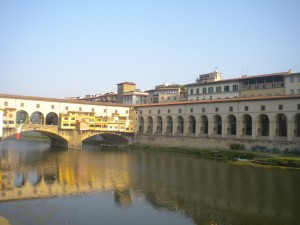 Florence is full of activities and events as well as sights and sounds and people, and if there are sometimes long silences between my entries, it is the silence of activity. This week I haven’t even had time to download Doctor Who.
Florence is full of activities and events as well as sights and sounds and people, and if there are sometimes long silences between my entries, it is the silence of activity. This week I haven’t even had time to download Doctor Who.
After describing the many festivals that flood the centro with activity, I went – in all innocence – to the market Saturday morning only to find my return blocked by a vast Noah’s arc built out of Chianti bottles drawn by pure white bulls and accompanied by the guild representatives, flag tossers, and girls in peasant wear handing out autumn fruit, all squarely between my fresh salmon steak and my refrigerator. It was the festival to celebrate the new wine, since the earlier Chianti harvests had just finished their fermentation, producing the young, extra-fruity un-aged wine one only gets in October. Sunday another 10 AM marching band (just one this time) roused me from snoozing. What would it be this time? Public banquet? Patron saint? A groggy descent revealed a wall of emerald green cotton and numbers, since a run for Cancer had flooded the city with literally thousands of Italians of all ages in matching t-shirts, who when I arrived were flooding in a great mass north toward the cathedral. It was quite a fight getting out the front door.
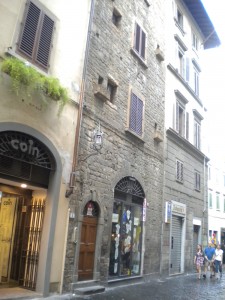
Now, 2,000 green-clad runners or no, opening my front door is generally a… I would say suspenseful act, but since I live at the top of a medieval tower, the descent of 111 steps takes so long that one falls into a kind of distracted hypnotic zen state half-way down, so even friends who visited have said that they, like me, tend to reach the bottom having completely forgotten why they were descending at all. It’s an experience like waiting at a bus stop or going to the bathroom, when you know there is no other activity you can or should be doing, so the mind is free to flit from path to path until you’re mulling about a friend’s Christmas present or a book you read fifteen years ago, and your mind is still on that when you open the front door and–bam!–nun in your face! That was four days ago, a lively old nun habbited in tan and gray (four points, +5 for driving a car; in my game you score different numbers of points for spotting nuns of different colors doing different things, and tan and gray is rare), there she was three feet from my face when I swung the door back. There’s a front step outside the door, and there is always someone sitting on it eating a gelato or consulting a map, and this morning it was an old man chatting with a nun driving a station wagon who had pulled up so close that I had to slide sideways down the length of the car to gain my liberty. Another day it might be a clutch of arguing Russians, or a lost Japanese art historian, or football fans giddily stripping the shrink wrap from their treasures purchased at the Florence football team merchandise shop right next door.
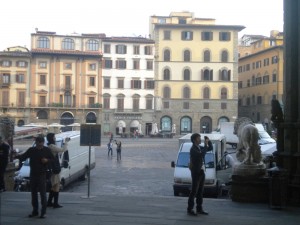 It is a rather different drama opening the door before 8:30 AM. The early bus to the institute rouses me often now in the hours when Florence herself wake up. Her morning face is altogether different. Like the ancient Romans, the Florentines have the good sense to banish commercial traffic to off-hours, so every dawn a fleet of trucks and vans, compact and white for the most part, diffuses through the city to supply the many shops and restaurants. The Disneyland crowds don’t rise until after nine, so in the slanting dawn light, as the last street-cleaning machines Zamboni their way across the cobbles, only a scattering of groggy early-bird tourists stand by churches or statues reading from fat guidebooks or clicking away with the elaborate, heavy cameras carried by those serious enough to set an alarm, even on vacation, in hopes of catching Florence without her crowds. My front door is often blocked by a load of soda bottles, vegetable crates, or infinite bottled water.
It is a rather different drama opening the door before 8:30 AM. The early bus to the institute rouses me often now in the hours when Florence herself wake up. Her morning face is altogether different. Like the ancient Romans, the Florentines have the good sense to banish commercial traffic to off-hours, so every dawn a fleet of trucks and vans, compact and white for the most part, diffuses through the city to supply the many shops and restaurants. The Disneyland crowds don’t rise until after nine, so in the slanting dawn light, as the last street-cleaning machines Zamboni their way across the cobbles, only a scattering of groggy early-bird tourists stand by churches or statues reading from fat guidebooks or clicking away with the elaborate, heavy cameras carried by those serious enough to set an alarm, even on vacation, in hopes of catching Florence without her crowds. My front door is often blocked by a load of soda bottles, vegetable crates, or infinite bottled water.
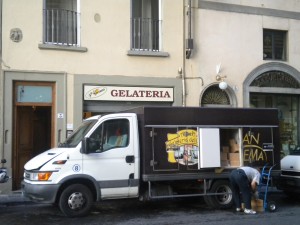
And bad gelato.
There you see it, unloaded box by heavy box, seeming to smoke as ice mist wafts from the freezer vans which deliver the unforgivable black underbelly of Florence’s cuisine. I am very serious about gelato, my friends, as one should be about one of the great achievements of our civilization, so it is with no hyperbole that I call it sin when these places serve this artificial, plasticy sugar gook produced in vast vats in the hidden countryside and smuggled in at dawn to masquerade as one of Italy’s great art forms. O tempora; o mores!
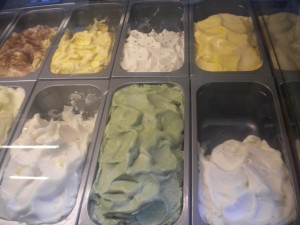
Some places, true, do serve a decent delivery gelato, and in places like Venice one can do no better, but the difference between McDonald’s and a fine flame-roasted burger dribbling salt and savor is not more radical than between this bad gelato and the real produce of fruit and milk and human energy served at the places where they make it real, fresh, each day. Bad gelato has its charm, much as lollypops or macaroni and cheese from a box are sometimes satisfying, but just as one doesn’t choose a lollypop over fresh black raspberries dipped in Godiva chocolate, when in somewhere serious like Florence Don’t Eat Bad Gelato! Don’t Do It! Look at it! Sitting there in its slimy saccharine flatness like mediocre yogurt! True gelato is the color of the real substance it’s made of, not its color-coded artificial form, and tastes, well, not like something flavored with a substance but like the substance itself, not strawberry flavor or banana flavor but an actual strawberry, an actual banana, but amplified and intensified, distilled past its natural perfection.
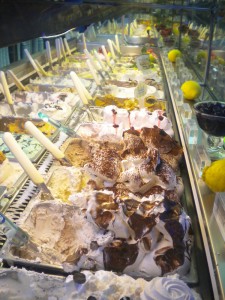
Sometimes, I confess, I break down and find myself calling out to people I see walking into bad gelato places. “Excuse me, I don’t mean to intrude, but there’s a much better and much cheaper real gelato place on that corner right there!” I try not to do it too often, but I can’t watch! I just can’t watch. Sometimes I hear it from people in the US, “You know, I went to Italy and the gelato there wasn’t any better than at XYZ place here in the states!” I shudder every time. It’s true, and if an Italian went to America and ate MacDonald’s he might report at home with honesty, “Their burgers aren’t any better than we have here.” That is why I sigh watching the cold vans trundle past, and why I still say, after “Dov’è il bagno” (where is the bathroom) the most important phrase to know in Italian is “Cerco una gelateria buona, con gelato vero, fatto con ingredienti fresci, non artificiali.” (I’m looking for a good gelateria, with real gelato, made with fresh ingredients, not artificial ones.)
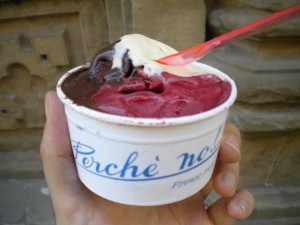 To the left, a cup of genuine top quality gelato, from Perche No!… (Why Not!…), my favorite Florentine gelateria and certainly the best in the center, especially for the fruit flavors. In the front you see Frutti di Bosco (fruit of the forest i.e. berry, combining raspberries, blueberries, blackberries, strawberries and redcurrants.) Note how the color is rich and dark, what you would get if you just put the fruits in the blender and let her rip. In the back the pale, unappetizing green gelato is made of fresh figs, speckled with their seeds, and divine. A good gelato place also only makes gelato with fruits in season, so fig is the autumnal treat.
To the left, a cup of genuine top quality gelato, from Perche No!… (Why Not!…), my favorite Florentine gelateria and certainly the best in the center, especially for the fruit flavors. In the front you see Frutti di Bosco (fruit of the forest i.e. berry, combining raspberries, blueberries, blackberries, strawberries and redcurrants.) Note how the color is rich and dark, what you would get if you just put the fruits in the blender and let her rip. In the back the pale, unappetizing green gelato is made of fresh figs, speckled with their seeds, and divine. A good gelato place also only makes gelato with fruits in season, so fig is the autumnal treat.
Imagine if you will the perfect snoozing morning. September is just beginning to cool from summer to real fall. Slices of sun stray between the shutter slats, striping the bed with warmth. The constellations on the midnight blue comforter have long since exhausted their reserves of glow-in-the-dark, but it’s time for the gold and orange sheets to glow with the morning’s sunny fire. The mosquitos are tucked up snug in their puddles for the morning, leaving buzz-free peace. After a late night finishing a satisfying project, the day ahead has nothing but small tasks in store, all fun, none urgent.
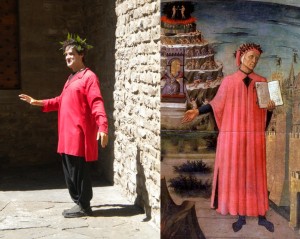
Tum! Ta-ta-tum! Ta-ta-tat-tat-tat-tat-tat-tat-tum!
“Marching… band…?” Yawn, rub eyes, repeat.
It’s a marching band, all right. It takes some time to verify, since life in Florence’s heart has a constant soundtrack: the morning accordion player with his Hollywood Hits medley; the mobile ensembles, dominated by clarinet and fiddle, that serenade the lunch and dinner hours; the mechanical brass when the evening carousel fires up; the crooning guitarist who charms tourists with nostalgia of “Let it Be” and “Yesterday”; and the Bad Clown with his grand orchestral boom box who performs at 9:10 on the dot each night and summons vast (soon-to-be-disappointed) crowds with his succession of blaring familiar classical masterpieces. This is definitely different. I play this game often, trying to sort new, desirable live music opportunities from the stream of regulars.
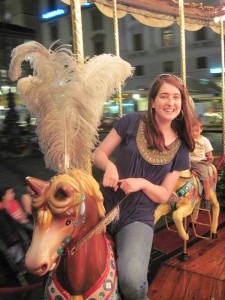
It helps that I’ve memorized the daily cycle by now, so it’s easy to say that at 10:10 on a Sunday morning this particular thunderous march of tubas is not normal.
I’ve learned to always run down, promptly, for live music that seems to be moving. There’s plenty of stationary stuff—orchestras from around the world drop by to play in various piazzas several times a week, but drums and marching mean a parade, and in Florence a parade may mean historical costumes, flag tossing, trumpets, medieval standards, armor, the archbishop blessing the militia, the usual. I used to try to continue working in my room as the trumpets triumphed by, but it’s not worth-it. Resisting just means I miss the beginning, and they’re all worth seeing, all unique.
For example, within the last few weeks have passed by my bedroom:
The feast of Saint Anne, a day on which Florence was saved , so celebrated by the Merchant Guilds of Florence parading and hanging their banners on their home church of Orsanmichele:
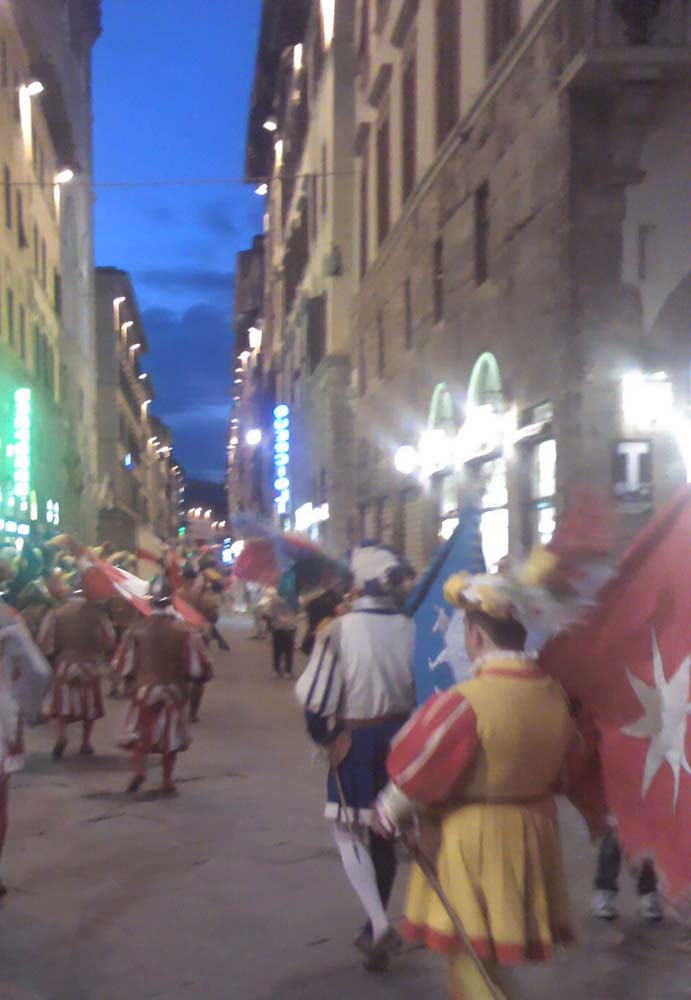
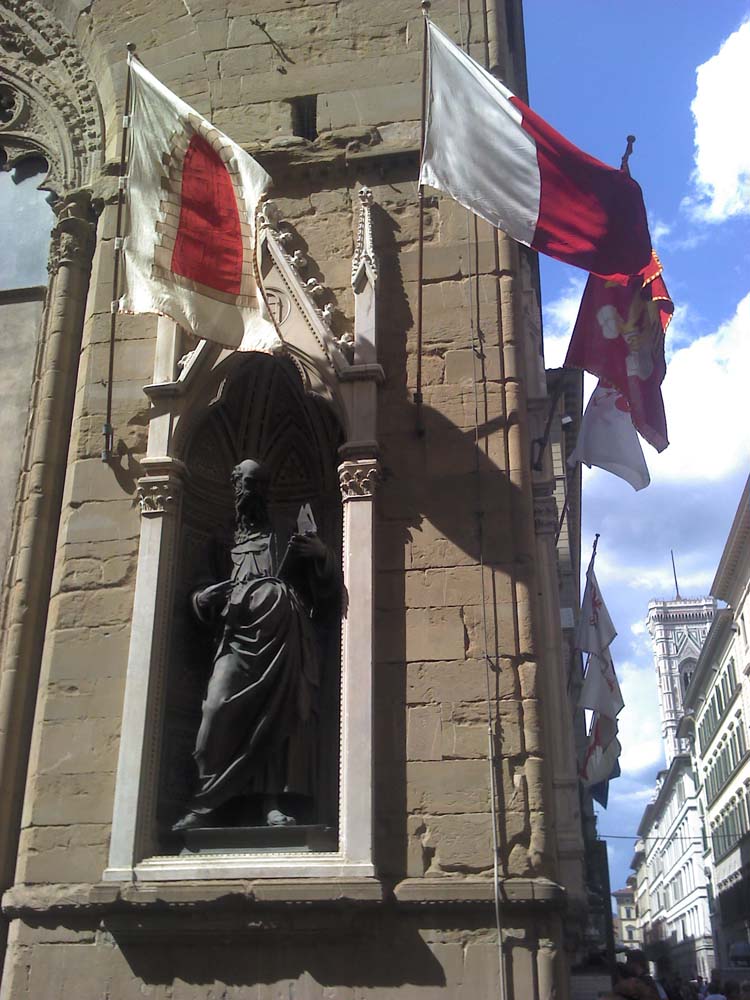
The “Codex Fiorentinus” with the laws governing the Guilds and Renaissance City (facsimile) is also solemnly carried in the parade:
The feast of San Lorenzo, which I already talked about, when the relics are displayed, the people blessed by the archbishop, and the guild representatives attend a special mass with the Archbishop:
The Festa della Rificolona, a Halloween-like festival when kids from around Florence carry paper lanterns to the piazza della Santissima Annunziata (where the old orphanage was) in honor of the birth of the Virgin:
The kids are also invited to try to rip and pierce each others’ lanterns using blow-guns made out of pieces of metal pipe that shoot little wads of clay. I experienced several glancing stings as I watched. This is something which those of my colleagues who are parents said their kids particularly enjoyed, both for the general fun and the thrill of realizing, as even 10-year-olds did, “We’d never be allowed to do this in the US!”
Only a couple days later came a festival in which period militia men paraded to the cathedral and were blessed by a high-ranking cleric (After a while I don’t have the energy to look up which festival is for what saint anymore…)
Followed by performances by flag-tossers (sbandieratori – an Italian invention, who demonstrate their skill tossing the banner of the city or guild, which must never touch the ground or it means great dishonor!):
I have pictures of the town covered with Italian and Florentine flags and I remember it must have been a festival, but I haven’t the foggiest recollection of what, or when:
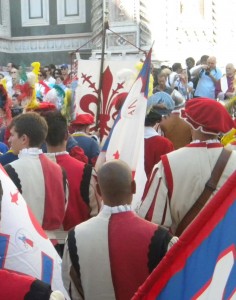
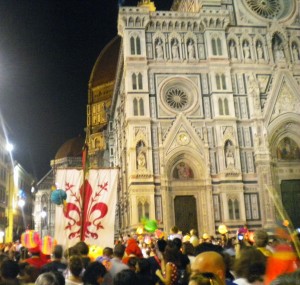
The one perennial attendee at these events is the Gonfalone, the great standard of the city of Florence. It’s always paraded at the head or displayed at the heart of the festival. When I get down into the street there’s no way to predict what I’ll find or where it’ll be headed (the route between Cathedral and Palazzo Vecchio are most common, but parades may detour to any number of churches or landmarks), so the best bet is to look for the Gonfalone and follow it.
So the sounds of the marching band, however inconvenient on such a lovely morning, mean I must go down to see what this latest festa has to offer. Snatch yesterday’s clothes off the floor, guzzle some orange juice (mmm… Sicilian blood orange juice, fiercer than grapefruit and almost strong enough to burn…), down.
Oh. I was wrong.
It’s not a marching band.
It’s thirty marching bands.
10 AM on Sunday morning is the best time for Florence and its allied cities to hold a marching band convention.
Each band comes from a different comune around Florence, and proudly brings its own Gonfalone, which gather in front of the Palazzo Vecchio. I stopped counting at thirty…
But even so, the bands would not begin their finale (30 bands playing the National Anthem together!) before the great Gonfalone of Florence was displayed on the balcony above, accompanied by the fanfare of its attendant trumpeters.
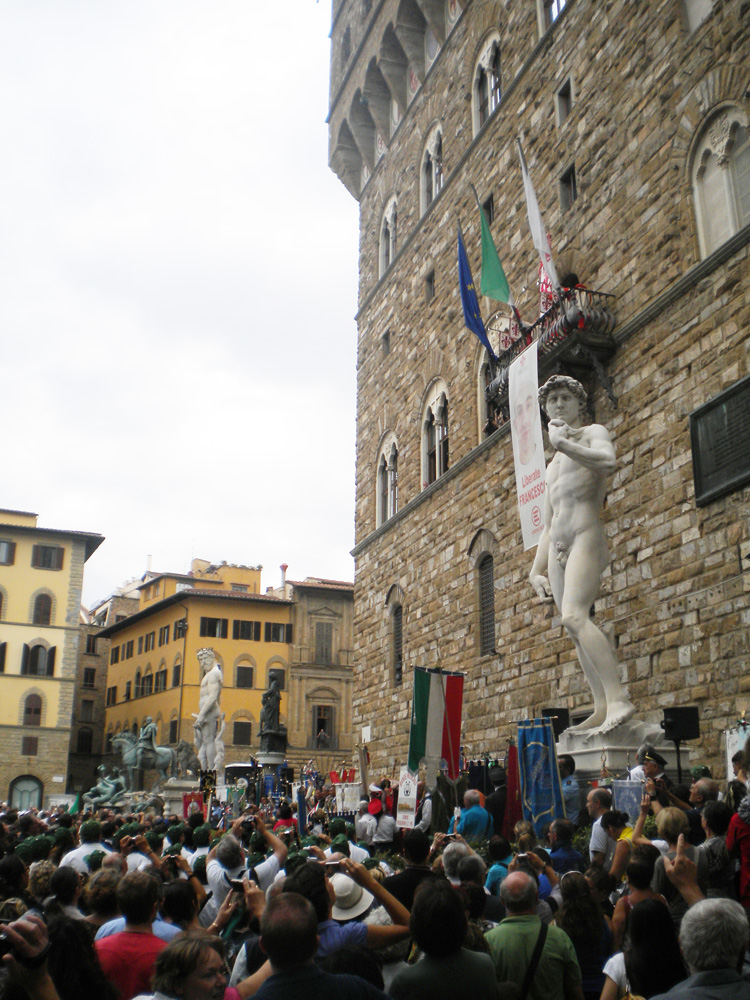
It was a delightful morning, if not the one I had expected. Only two flaws cropped up. One was when my stomach growled:
Much crowd-dodging and baton-twirling later I obtained a tolerable panino. The other problem came when the festival finished, and it came time for thirty marching bands to all leave the square at the same time. The parade in had been carefully timed, but the exodus seemed to have no planning whatsoever. Actually, all the way through crowd control had consisted of a bunch of plainclothes people randomly shouting at the infinite tourists to move, or stop, or go, and when bands began to collide there were many frantic confrontations between men in suits and squads with pompoms. Still, ended…what the?! It’s hailing! Suddenly as I’m writing this, balls of ice about a half inch across are plumetting from the sky and thundering across the temptingly-climbable rooftops. Okay, fess up! Who forgot a saint’s day? Sigh. Clearly the solution is more festivals… Now, excuse me while I go rescue my fragile basil.
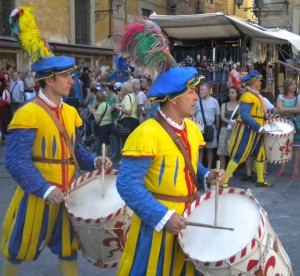
Florence is always having festivals, partly because every day is some saint’s day by now, but also because when the Republic of Florence decrees in 1397 that thenceforth they will provide a feast for all the people in honor of San Lorenzo on his feast day of August the 10th, they mean it, and however many successive regimes may rule said republic, the custom remains. These are what one might call real Renaissance festivals, and the banners and livery that many of us are used to seeing at reenactments have an infinitely more organic feel when, instead of play, the feeling is of habit and obligation, and that this tired old tunic has been dug out and brushed off every year since tunics were a new thing.
Of course such festivals do feed the tourist trade, so the pageant is in part display for outsiders, but as the city standard and guild banners are borne proudly past crowds who haven’t the foggiest sense of their significance, there is a distinct sense of reality and continuity which contrasts with the (however faithful) nostalgic feeling of a reenactment.
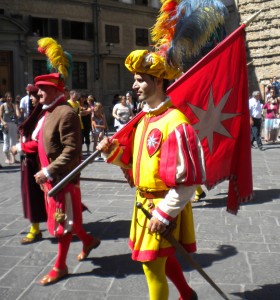
There is no nostalgia in this pageant, since everything involved: the church, the people, the city officials with their boring speeches, the saint’s cult, and the promised feast, are still normal, no more nor less serious now than they were when a youthful Machiavelli waited in the same line for a free meal.
The official city standard makes a universal appearance at these things, proudly displaying the city’s crest. The title Gonfaloniere di Giustizia or Standard-Bearer of Justice was the title of the most prestigious and important position in the Republic, and while one doesn’t picture politicians actually carrying the spear around, the procession of the standard, guarded by officers in white and red livery and floppy Renaissance hats, standing solemnly through the whole mass holding their charge, remains a thrilling sight. As does the real live politician following it in, who holds the successor to that noble office.
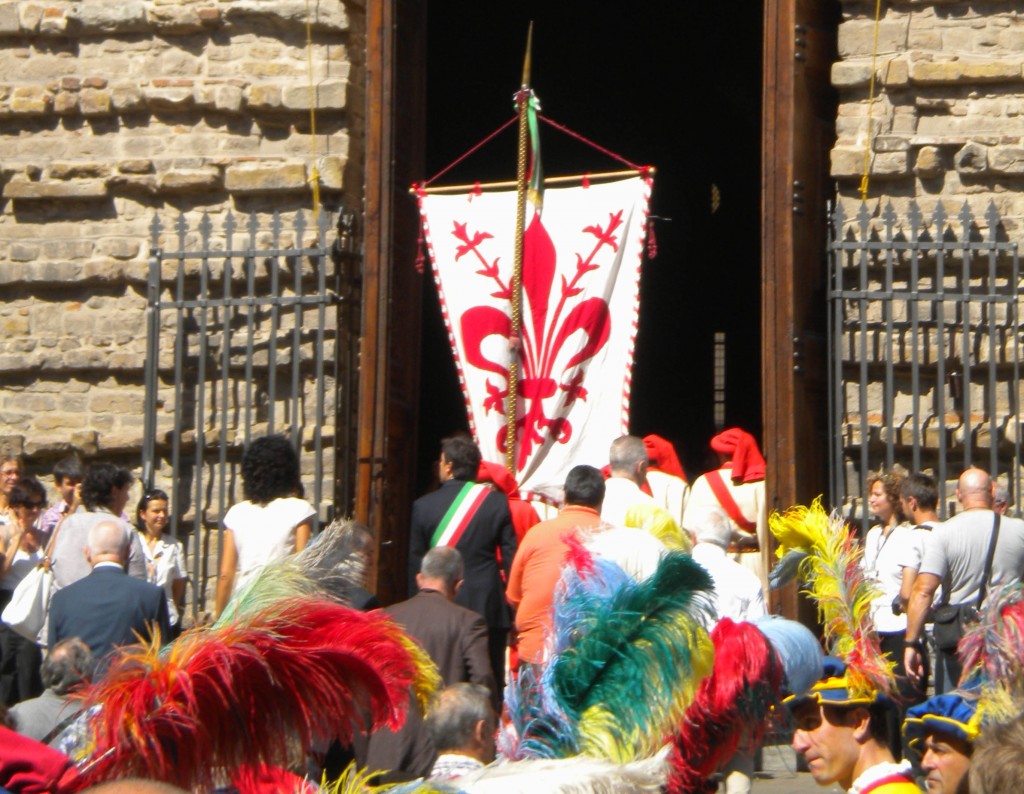
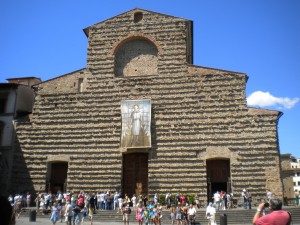
The Basilica of San Lorenzo in Florence is a church I have visited many times and shall visit many more, in person and in my discussions. While my usual focus in visiting is the excellence of its neoclassical architecture and the brilliant design of the various Medici tombs therein, on August 10th it must be instead its dedicatee. San Lorenzo (Saint Laurence in the anglophone world) is a saint particularly relevant to many of us, and has the enviable distinction of being the Patron Saint of both libraries and chefs. The former office he acquired, along with being patron of archivists and notaries, because of his activities as one of the early administrative deacons who ran finances and record-keeping of the early Roman Church; the latter for being grilled alive at the order of Emperor Vespasian, August 10 259 AD. He is one of the earlier martyrs, and one with a short but excellent set of associated anecdotes.

Discovering Lorenzo and his office, Vespasian commanded him to hand over the treasures of this illegal cult. Given three days to prepare, Lorenzo emptied the treasury, giving everything he had to the poor. When summoned to present the treasures to Vespasian he instead brought a company of the poor, sick and crippled, declaring that these were the treasures of the Church. He is supposed to have been good-natured about his execution, and is rumored to have said when he was being grilled alive something along the lines of, “Flip me over, Caesar, I’m done on this side.”
San Lorenzo has several churches in Rome, including the church of San Lorenzo in Miranda (better known to classicists as the church they built in the middle of the Temple of Antoninus and Faustina, where San Lorenzo was supposedly sentenced), and San Lorenzo in Panisperna which has the famous grill on which he was executed, which he also carries quite reliably in art, making him one of the easiest saints to recognize when one plays the never-ending art game, “Spot the Saint”.
San Lorenzo’s basilica in Florence might in fact be the oldest church in Florence – several fight for the title, excluding rivals by using various definitions of “Florence” based on different past locations of the city walls.
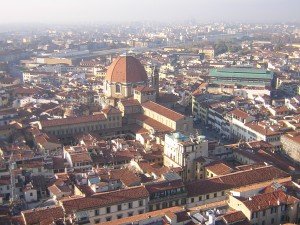
The eleventh-century original was replaced over the course of the 1400s by a new Romanesque church, intended to be showpiece of the new architecture based on the recently-rediscovered Vitruvius and other glories of the lost Roman arts. Originally it was to have been paid for by the city with one chapel financed by the Medici, but when the Medici contribution was nicely done and the rest still languishing almost untouched, the Medici (who totally didn’t rule the city honest we didn’t) offered to step in and pay for the whole thing. Good publicity for the Medici all around, and it became the family’s traditional burial church. The great Laurenziana Library, containing the former Medici collections and many other manuscripts, is still attached (and currently doing a feature exhibit on the oldest and most complete surviving ancient collection of Virgil). The facade of the church, as you can tell, was never finished, due to some legal quarrels and artist deaths and Michelangelo having another row with the pope and all the usual, but the inside…
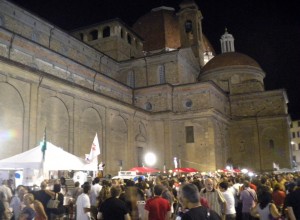
…is not our concern today. Today’s concern is that the city has promised to give a free feast to the populace this night every year forever, and they’re not about to fail in 2011. Not quite. You see, excellent as the parade part of the festival is, feeding 1,000 Florentines, and 1,000 attending tourists, requires a great deal of logistics and discipline, and was organized by… well… Florentines.
Our goal for the night? Distribute watermelon, yogurt cups and pasta to an enormous mob.
They erected metal barriers, like you do, to organize the line into two files, then had a series of tents in which the watermelon was sliced and the pasta heated by burly men, then women with trays to carry them to the people
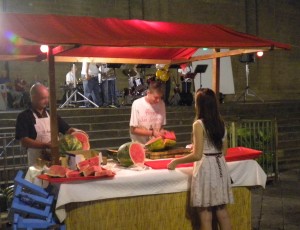
By carry them to the people, I mean wander confusedly toward the mob and hold out trays until hands grabbed things in a vast, crushing mass. The immediate effect was that a lot of us got in lines, and then huge numbers of people streamed past the lines, going around the barriers to the middle, and shoving in, getting food from the confused women, and leaving again past the people still waiting in the line.
The consternation of those in line was matched only by the unblinking calm of the hundreds streaming to cut in line, who were either blissfully unaware of the situation or equally blissfully uncaring. The whole stream just flowed past us, smiling and shoving, while we stood stock still, with an increasing number of complaints rising from the veterans who put up with this every year.
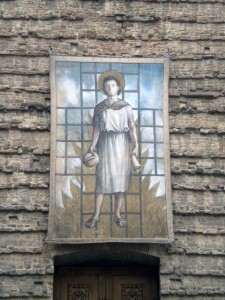
Watermelon was the first item to manifest, and here a new problem arose. Those in the front of the mob were shoved up against the front rails by the booths, along which it was necessary to advance to reach the pasta. Those with watermelon brought it, and we ate it, but had no way to escape the area even if we wanted to since there was an enormous mob behind us. Thus the dozens who already had watermelon blocked the hundreds who had not, with no escape in sight. There was also nowhere to put the peels, resulting in hundreds of people standing in a tight mob either holding our dripping and sticky watermelon rinds, or attempting to hurl them over the head of the crowd into large, distant dumpsters, with mixed success. And soon there was no one left who wanted watermelon, at least not that could get near.
After 2 hours of holding watermelon rind, I finally advanced to the pasta stage and discovered the next brilliant plan. There were only two men working the pasta booths, and it took about two full minutes for them to do each batch, which was about 6 bowls. 12 bowls every two minutes, 1,500 people give or take, so… a process which started at 10 PM was still well underway at midnight when I escaped with the hardest-earned bowl of pasta I’ve ever eaten.
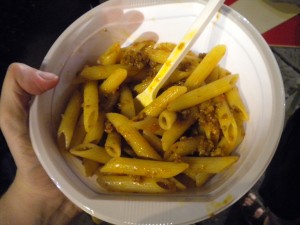
It was a Tuscan specialty, ground meat with a little tomato, not much else. But it will remain one of the most memorable pastas I’ve tasted, partly for the chaos of its acquisition, but more for the thought of so many previous Florentines (Michelangelo, Benvenuto Cellini, young Marsilio Ficino) fighting what I’m sure were equally-organized mobs. You know, the tradition of handing out pasta at these things originated before the tradition of handing out silverware. Yogurt, I hope, is modern.
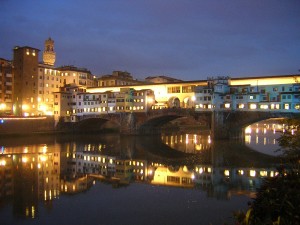
Me – I’m going to stay inside all day and do work.
Florence – But I’m Florence. Florence is better than work.
Me – No, I’ve been here more than a week now, it’s time I wrote some Ex Urbe entries and shared some of what I’ve done so far.
Florence – I have pizza…
Me – I went to more than a dozen museums, and so many restaurants to describe!
Florence – Gelato…
Me – It’s Vasari’s birthday; I really want to write about him today.
Florence – Frescoes, sculpture…
Me – You’ll have frescoes tomorrow.
Florence – But I have perfect weather today, cool and breezy and just humid enough.
Me – I opened the windows.
Florence – A beautiful sunset, curls of twisty pink cloud growing steadily purple as the sky turns richer and richer blue, wouldn’t that look amazing next to the green and white stripes of my Baptistery, or the gold stone tower of the Palazzo Vecchio?
Me – Look, I’m just trying to write home about how wonderful you are! Can’t you stop being so wonderful for a few hours?
Florence – I have live music.
Me – I don’t care.
Florence – A live orchestra tucked away in one of the squares below, notes drifting up: Bach, then Vivaldi, you know you love Vivaldi…
Me – I’m not listening.
Florence – Crowds cheering, drums…
Me – Not listening.
Florence – Fireworks…
Me – Wait, really?
Florence – Fireworks, crackling, over by the Duomo, just low enough that you can’t quite see them beyond the houses. You know I haven’t had fireworks by the Duomo since Easter.
Me – … … …
I lost.